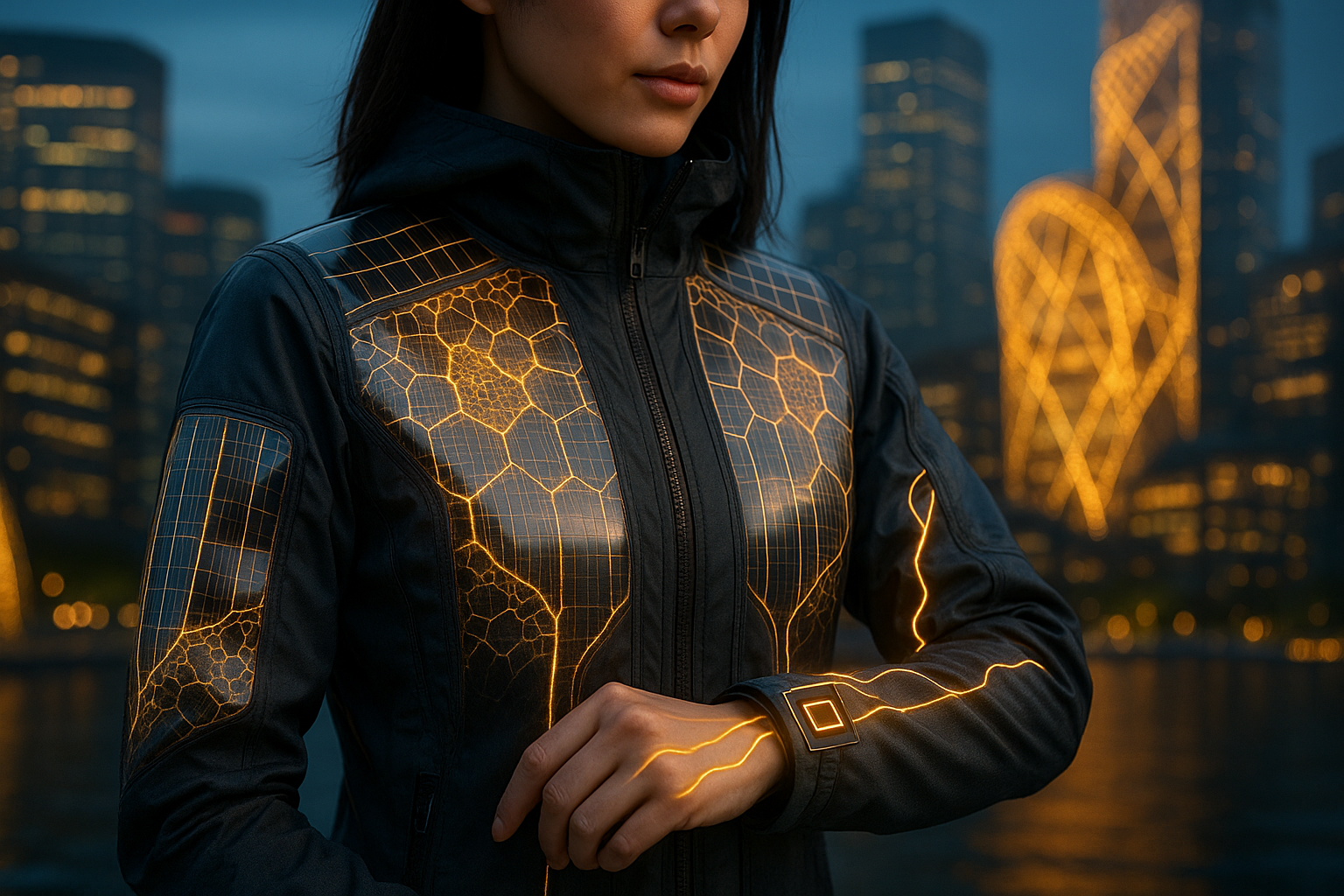These ultra-thin bendy solar panels are so light you can wear them
The era of bulky, rigid silicon-based solar panels is rapidly becoming a relic of the past. In its place is emerging a revolutionary energy paradigm—one defined not in meters and kilograms, but in microns and grams . Welcome to the age of ultra-thin, bendable solar technology , where power generation becomes invisible, wearable, and seamlessly integrated into our daily lives.
Imagine solar cells so light they can rest atop a soap bubble without popping it, so flexible they can be woven into fabric, and so efficient they can draw power from indoor lighting. These aren’t futuristic fantasies—they’re real technologies being developed and deployed today.
Let’s explore how this transformation is unfolding across science, engineering, and industry—and what it means for the future of sustainable energy.
Beyond Silicon: The Perovskite Revolution
For decades, silicon has been the backbone of photovoltaic (PV) technology. While effective, traditional silicon solar panels are heavy, rigid, and expensive to manufacture. Enter perovskite , a class of crystalline materials named after Russian mineralogist Lev Perovski.
Perovskite solar cells (PSCs) are now at the forefront of next-generation solar innovation due to their:
Featherlight Design
Perovskite solar cells weigh less than 4 grams per unit —lighter than a single sheet of paper. Their thinness (often less than 1 micrometer) allows them to be embedded into textiles, windows, and even skin-like sensors without adding weight or rigidity.
Low-Light Performance
Unlike conventional solar panels that require direct sunlight, perovskite cells excel in diffused light conditions —such as cloudy days, indoors under LED lighting, or during rain. This opens up entirely new applications, like powering wearables or smart home devices.
Tunable Efficiency
Perovskite materials can be chemically engineered to absorb different parts of the light spectrum, including visible and infrared wavelengths. In lab settings, these cells have already achieved efficiencies over 26% , rivaling the best silicon panels.
Real-World Application: Expo 2025
At Expo 2025 in Osaka , companies like Toyoda Gosei and Enecoat Technologies showcased the first-ever wearable integration of perovskite solar cells. Workers wore vests equipped with these films to power neck fans, offering a glimpse into the future of cooling solutions powered by ambient light.
Engineering the Unbreakable: Durability Breakthroughs
Early versions of flexible solar cells were prone to degradation and mechanical failure. But recent advances in material science and encapsulation techniques have made ultra-thin solar both durable and practical .
Organic Solar Cells (OSCs): Flexibility Meets Functionality
Organic solar cells use carbon-based polymers such as P3HpT blended with fullerenes (carbon spheres). These cells maintain 80% efficiency after 1,000 bending cycles , making them ideal for wearable electronics and skin-mounted sensors . They can endure compressive strains of up to 75% , ensuring resilience under repeated flexing.
Encapsulation Armor: Protection at the Microscopic Level
MIT researchers have pioneered a dual-layer protection system:
- Parylene C : A 1-micron thick polymer layer that acts as a moisture and oxygen barrier.
- Dyneema Fabric : A high-strength synthetic fiber known for lifting sunken ships, used here as a lightweight substrate.
This combination achieves an impressive 370 W/kg —nearly 18 times more power per kilogram than traditional silicon panels.
Standardizing Flexibility
To ensure real-world reliability, a global team led by Spain’s Universitat Rovira i Virgili developed the first standardized bending test for flexible PV cells. Their protocol subjects cells to 1,000 bending cycles at 1% strain , establishing benchmarks for durability in commercial applications.
Comparison Table: Wearable Solar Technologies
| Technology | Thickness | Efficiency | Key Advantage |
|---|---|---|---|
| Perovskite | < 1 µm | 21.2% (tested) | Low-light performance |
| Organic (OSC) | ~15 µm | 10–15% | Extreme flexibility |
| Silicon | 150–200 µm | 15–22% | High durability |
| Quantum Dot | Nanoscale | >18% (lab) | Tunable light absorption |
Real-World Applications: From Runways to Rescue Missions
Ultra-thin solar is no longer confined to labs—it’s entering mainstream industries, transforming fashion, emergency response, space exploration, and more.
Fashion-Forward Power
Companies like Pvilion are producing solar-powered jackets that charge phones via built-in panels. Meanwhile, MIT has demonstrated fabric-integrated solar cells that can adhere to backpacks or tents, achieving 730 W/kg when freestanding.
Emergency Response
German research institute Fraunhofer IKTS has developed rollable solar tarps capable of powering field hospitals. These durable panels survive industrial processes like high temperatures (up to 200°C ) and large-scale manufacturing runs (1,000-meter rolls ).
Space & Mobility
NASA is exploring ultrathin solar cells for satellites, significantly reducing launch weights. Meanwhile, Polish startup Saule Technologies has installed perovskite “smart poles” at Expo 2025, which power streetlights and electric vehicle charging stations using ambient light.
The Road Ahead: Challenges & Horizons
Despite remarkable progress, several challenges remain before ultra-thin solar becomes ubiquitous.
Stability & Toxicity
One major issue with perovskite solar cells is their rapid degradation under UV exposure and humidity—sometimes failing within weeks.
Solutions:
- Stabilizing agents like organosilanes can extend lifespans by tenfold.
- Lead encapsulation techniques (e.g., glass laminates or polymer barriers) prevent toxic lead leakage from damaged cells.
Scalability & Integration
While lab-scale prototypes show promise, scaling production remains complex. MIT researchers use slot-die coating —a printing technique—to mass-produce perovskite films cost-effectively. However, maintaining uniform quality over large areas is still a challenge.
Hybrid Systems
To bridge the gap between efficiency and durability, companies like Oxford PV are developing perovskite-on-silicon tandem cells that boost output by 20% , combining the best of both worlds.
Future Applications of Wearable Solar Technology
| Sector | Application | Impact |
|---|---|---|
| Healthcare | Insulin pumps, hearing aids | Continuous power without batteries |
| Architecture | Solar blinds, facades | Buildings generate power invisibly |
| Transportation | Truck tarps, drone wings | Fuel-free auxiliary energy |
| Consumer Tech | Smartwatch bands | Eliminate daily charging |
The Energy Harvesting Future
Beyond wearables, ultra-thin solar is poised to enable ubiquitous energy harvesting —powering the Internet of Things (IoT), smart cities, and autonomous systems.
IoT Ecosystems
Researchers at Huazhong University are developing stretchable organic solar cells that could power distributed sensors across smart cities, enabling self-sustaining networks of environmental monitors and traffic controllers.
Energy Autonomy
Dr. Denise Wilson of the University of Washington envisions a world where clothing itself generates electricity , freeing us from outlets and reducing battery waste.
Aesthetic Design
At Expo 2025, Panasonic is showcasing artistic perovskite-infused glass facades , proving that solar technology can be both functional and beautiful.
As Vladimir Bulović , director of MIT.nano, states:
“Lightweight solar fabrics accelerate adoption by enabling integrability… We must deploy carbon-free energy urgently.”
Wearing the Future
Ultra-thin solar panels are more than just a technological advancement—they represent a paradigm shift in how we interact with energy. No longer confined to rooftops or solar farms, power generation is becoming integrated , invisible , and personal .
From clothing to construction, from healthcare to outer space, the convergence of perovskite , organic , and quantum dot technologies heralds a future where generating clean energy is as effortless as wearing a shirt.
As factories retool, standards evolve, and innovations scale, the dream of living off-grid—powered by light—is no longer distant. It’s unfolding—stitch by conductive stitch , panel by transparent panel.
In this new energy landscape, humanity’s relationship with power transforms from one of consumption to seamless, sustainable coexistence.



